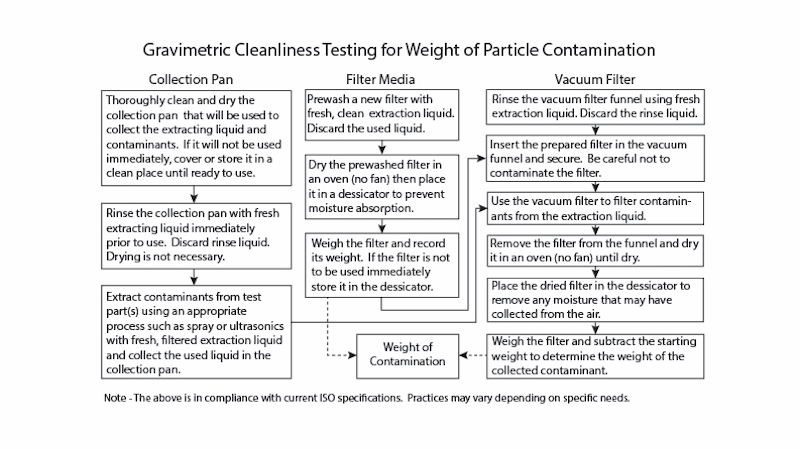Millipore testing is all about evaluating cleanliness based on the presence of particles or other solid, non-soluble contaminants. In general, it can not be used to detect the presence of hydrocarbons or other contaminants which will be solubilized in the extraction process.
The results of Millipore testing are generally expressed by weight using gravimetric analysis or by the size and number of particles collected by extraction using manual or automatic means to size and count the particles. A gravimetric analysis consists of simply weighing the amount of contaminant collected by extraction process. Although I don’t know for sure, I believe gravimetric analysis preceded particle evaluation methods and, although less frequently used today than particle analysis, would appear to be the most precise and repeatable of the two. Although occasionally used together, most analysis uses either one discipline or the other. The exception is in the case where total weight must not exceed a particular value AND the largest particle must not exceed a particular value.
Gravimetric Evaluation
The first step in gravimetric analysis is extraction of the particles to be weighed. This is done using one of several techniques detailed in various specifications. Extraction results in collected particles being suspended in the liquid used to perform the extraction. The extraction liquid is then filtered to isolate the particles for weighing. The filter mesh is chosen to retain (to as great a degree as possible) only the particles of consequence. A filter retention of 2 microns, for example, would not be required if only particles of 50 microns or above in size are of concern. Before performing the filtration, the filter is pre-conditioned to assure that its weight will remain stable before and after the filtration process. Pre-conditioning usually involves a prewash using uncontaminated extraction liquid followed by heated drying and exposure in a dessicator to provide a fixed level of water absorption in the filter material. Using a filter of known weight allows the weight of collected particles to be determined by simply subtracting the starting weight from the weight measured after the collected particles are collected on the filter. Following the filtration process, the filter should be dried using the same method as for pre-conditioning to remove any remaining extraction liquid and then held in a dessicator re-establish the initial degree of water absorption.
When applied properly, gravimetric analysis of Millipore testing results generally provides a much more stable and reliable number than automated or manual particle counting analysis. It should be used in cases where particle size is relatively stable and particle size and distribution is not of concern. To its benefit, gravimetric analysis is less costly to perform owing to the fact that less sophisticated equipment is required. It is also more “forgiving” than particle analysis as it is not effected by the amount of contamination present as are automated particle counting techniques where particle density and orientation can often result in inaccuracy. To its detriment, gravimetric analysis does not allow easy identification of different classes of contaminants – metallic, non-metallic, transparent, opaque or fibers for example nor, does it provide a particle size distribution unless filtration is done in stages using filters with different retentions.
Millipore testing using gravimetric analysis has given way to more sophisticated analysis techniques but is adequate in many applications.
John Fuchs is a technology specialist for Blackstone-NEY Ultrasonics, a division of Cleaning Technologies Group. Fuchs has been involved in the ultrasonic cleaning industry since 1968. Read more of John's thoughts at https://techblog.ctgclean.com/




































